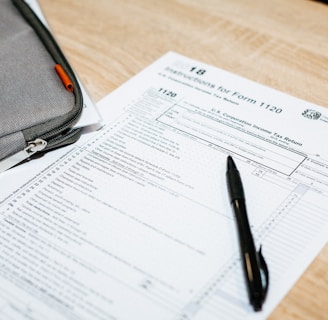Back Door Roth IRA: A Smart Strategy For High Income Individuals
How to execute a back door Roth IRA
RETIREMENTINCOME TAXES
Patrick M Scholz
10/8/20244 min read


The Backdoor Roth IRA: A Smart Strategy for High-Earners
For individuals who exceed the income limits to contribute directly to a Roth IRA, the Backdoor Roth IRA strategy offers a powerful way to still enjoy the tax-free growth and withdrawals that Roth accounts provide. In this blog, we’ll dive into what the Backdoor Roth IRA is, why it’s beneficial, and how to navigate this strategy effectively and legally.
What Is a Backdoor Roth IRA?
The Backdoor Roth IRA is a method that allows individuals who surpass the income thresholds for Roth IRA contributions to still benefit from Roth tax advantages. Essentially, it involves converting a Traditional IRA into a Roth IRA. Since there are no income limits on Roth conversions, this "backdoor" approach bypasses the usual income restrictions.
How Does the Backdoor Roth IRA Work?
Contribute to a Traditional IRA:
Even if your income exceeds the limits for deductible Traditional IRA contributions, you can still contribute to a Traditional IRA. In 2024, the IRA contribution limit is $6,500 ($7,500 if you're 50 or older).
Convert the Contribution to a Roth IRA:
After making your Traditional IRA contribution, you can convert it into a Roth IRA. There’s no income restriction on Roth conversions, so you can complete this step regardless of your income level.
Pay Taxes (If Necessary):
If your Traditional IRA contributions were non-deductible (meaning you didn’t take a tax deduction), there should be little to no tax liability when converting to a Roth IRA. However, if you have other pre-tax IRA funds, the pro-rata rule could trigger a taxable event.
Why Use a Backdoor Roth IRA?
The appeal of a Backdoor Roth IRA lies in the many advantages of Roth accounts:
Tax-Free Growth: Once your money is in a Roth IRA, it grows tax-free.
Tax-Free Withdrawals: In retirement, qualified distributions from a Roth IRA (those made after age 59½ and after holding the account for at least five years) are entirely tax-free.
No Required Minimum Distributions (RMDs): Unlike Traditional IRAs, Roth IRAs don’t have RMDs during the account holder’s lifetime. This allows your savings to continue compounding tax-free for as long as you want.
Estate Planning Benefits: Roth IRAs can be passed on to heirs, offering tax advantages to beneficiaries.
Who Should Consider a Backdoor Roth IRA?
The Backdoor Roth IRA is an ideal strategy for:
High-Income Earners: If your modified adjusted gross income (MAGI) exceeds the Roth IRA contribution limits—$153,000 for single filers and $228,000 for married couples filing jointly in 2024—you can still indirectly contribute to a Roth IRA through the backdoor.
Those Who Want Tax Diversification in Retirement: If you want a balance between pre-tax (Traditional IRA or 401(k)) and post-tax (Roth IRA) retirement accounts, a Backdoor Roth IRA can add flexibility to your retirement income strategy.
Investors with Long Time Horizons: Since Roth IRAs allow for tax-free growth, those with a long investment horizon (e.g., people in their 30s, 40s, or 50s) can benefit significantly from the compounded growth over time.
Key Considerations and Pitfalls
While the Backdoor Roth IRA is a powerful tool, there are a few considerations to keep in mind:
The Pro-Rata Rule:
The IRS requires you to calculate taxes on Roth conversions using all of your IRA accounts, not just the one you converted. This rule can lead to a higher tax bill if you have other pre-tax IRA funds. For example, if you have a mix of deductible and non-deductible contributions across multiple IRAs, you’ll owe taxes on a proportional amount of any pre-tax contributions.
Watch Out for Step Transaction Doctrine:
The IRS may scrutinize a Backdoor Roth IRA if it appears that the two steps (Traditional IRA contribution and Roth conversion) are treated as one transaction for tax avoidance purposes. To minimize risk, some advisors recommend waiting a short period—such as a few days or weeks—between the contribution and conversion steps.
Contribution Limits:
Although you can execute a Backdoor Roth IRA every year, the standard IRA contribution limits still apply. In 2024, the maximum contribution is $6,500 (or $7,500 if you're over 50), so the amount you can funnel into a Roth via this method is limited.
Future Legislation:
While currently allowed, the Backdoor Roth IRA may not always be available. Congress has debated closing this loophole in the past, so it’s essential to stay informed on potential legislative changes.
How to Execute a Backdoor Roth IRA in 2024
Executing the Backdoor Roth IRA is a straightforward process if you follow these steps:
Open a Traditional IRA account if you don’t already have one.
Contribute the maximum allowable amount to your Traditional IRA ($6,500 or $7,500 if you’re 50 or older).
Wait a short period (optional) to avoid any IRS scrutiny under the step transaction doctrine.
Convert your Traditional IRA to a Roth IRA, either through your financial institution's platform or with the help of a financial advisor.
File IRS Form 8606 when you do your taxes to report the non-deductible contribution and conversion.
Is the Backdoor Roth IRA Right for You?
The Backdoor Roth IRA can be a valuable strategy for high-income earners looking for tax-free retirement income and more flexibility with their withdrawals. However, navigating the pro-rata rule and understanding the tax implications are critical to ensuring the conversion works in your favor.
Consulting a financial advisor or tax professional before proceeding is essential, especially if you have existing IRA assets. With proper planning and execution, the Backdoor Roth IRA can enhance your long-term financial strategy and help you take full advantage of Roth benefits, regardless of your income level.
By using a Backdoor Roth IRA, you can build a tax-advantaged retirement portfolio while adhering to IRS rules and maximizing your long-term financial growth.
Corhaven Technologies LLC
245 Bayshore Dr
lake Bluff IL 60044
Planning and Advisory
Patrick@corhavenplan.com
(925)-705-5170
© 2024. All rights reserved.
